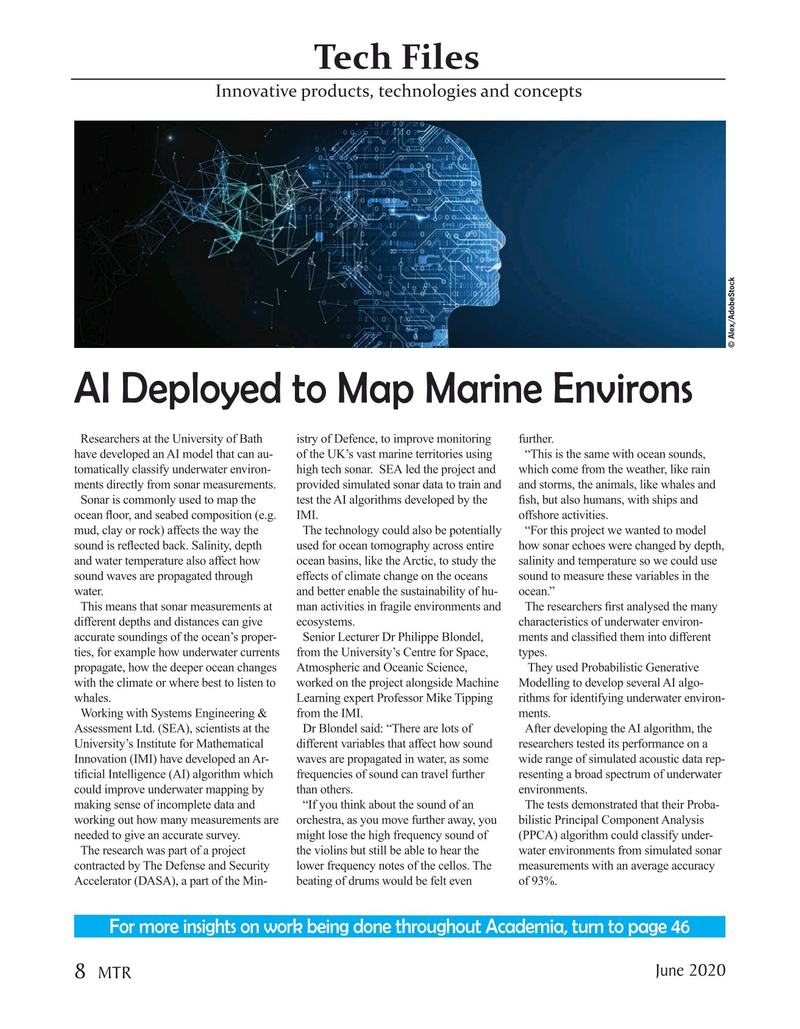
Page 8: of Marine Technology Magazine (June 2020)
Read this page in Pdf, Flash or Html5 edition of June 2020 Marine Technology Magazine
Tech Files
Innovative products, technologies and concepts © Alex/AdobeStock
AI Deployed to Map Marine Environs
Researchers at the University of Bath istry of Defence, to improve monitoring further. have developed an AI model that can au- of the UK’s vast marine territories using “This is the same with ocean sounds, tomatically classify underwater environ- high tech sonar. SEA led the project and which come from the weather, like rain ments directly from sonar measurements. provided simulated sonar data to train and and storms, the animals, like whales and
Sonar is commonly used to map the test the AI algorithms developed by the fsh, but also humans, with ships and ocean foor, and seabed composition (e.g. IMI. offshore activities.
mud, clay or rock) affects the way the The technology could also be potentially “For this project we wanted to model sound is refected back. Salinity, depth used for ocean tomography across entire how sonar echoes were changed by depth, and water temperature also affect how ocean basins, like the Arctic, to study the salinity and temperature so we could use sound waves are propagated through effects of climate change on the oceans sound to measure these variables in the water. and better enable the sustainability of hu- ocean.”
This means that sonar measurements at man activities in fragile environments and The researchers frst analysed the many different depths and distances can give ecosystems. characteristics of underwater environ- accurate soundings of the ocean’s proper- Senior Lecturer Dr Philippe Blondel, ments and classifed them into different ties, for example how underwater currents from the University’s Centre for Space, types.
propagate, how the deeper ocean changes Atmospheric and Oceanic Science, They used Probabilistic Generative with the climate or where best to listen to worked on the project alongside Machine Modelling to develop several AI algo- whales. Learning expert Professor Mike Tipping rithms for identifying underwater environ-
Working with Systems Engineering & from the IMI. ments.
Assessment Ltd. (SEA), scientists at the Dr Blondel said: “There are lots of After developing the AI algorithm, the
University’s Institute for Mathematical different variables that affect how sound researchers tested its performance on a
Innovation (IMI) have developed an Ar- waves are propagated in water, as some wide range of simulated acoustic data rep- tifcial Intelligence (AI) algorithm which frequencies of sound can travel further resenting a broad spectrum of underwater could improve underwater mapping by than others. environments.
making sense of incomplete data and “If you think about the sound of an The tests demonstrated that their Proba- working out how many measurements are orchestra, as you move further away, you bilistic Principal Component Analysis needed to give an accurate survey. might lose the high frequency sound of (PPCA) algorithm could classify under-
The research was part of a project the violins but still be able to hear the water environments from simulated sonar contracted by The Defense and Security lower frequency notes of the cellos. The measurements with an average accuracy
Accelerator (DASA), a part of the Min- beating of drums would be felt even of 93%.
For more insights on work being done throughout Academia, turn to page 46 June 2020 8
MTR

 7
7

 9
9
